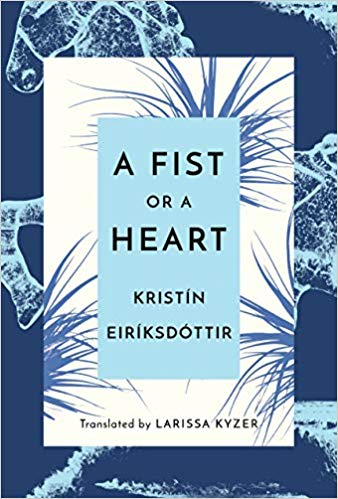A Fist or a Heart
- By Kristín Eiríksdóttir; translated by Larissa Kyzer
- Amazon Crossing
- 188 pp.
- Reviewed by Terri Lewis
- October 8, 2019
An eerie, fractured story of trauma, art, and relationships.

A Fist or a Heart, a novel by Icelandic author Kristín Eiríksdóttir in her English-language debut, begins with the description of a hand, its nails and skin, then meanders onto legs, toes, and feet. No indication of whose body this is, just hints of a family, of pain and cold.
Finally, the narrator becomes Elín, a prop-maker who wants to tell a story. It will be difficult to write because her “mind wanders from the material, leaves the pain behind, teeters on the rooftop.” Nonetheless, she will persevere because if she doesn’t tell it, no one will. The story is “not about a girl. Whose name is Ellen.”
Intriguing. Are Ellen and Elín the same person?
In quick succession, mysterious glimpses propel the reader forward: boxes with the narrator’s name on them in an unknown room of her deceased grandmother’s house; a decision to create props for a play Ellen has written; a tiny glass horse; and the fact that Elín “accidentally got mixed up in the most salacious story of them all.”
The reader is primed for a journey and hopes it will end with the details pulled together into a satisfying whole.
At a reading of the play, we meet Ellen for the first time. She’s not yet 20, and everyone says the production is a work of genius. It’s not clear whether this is true or if the adulation is because she’s the daughter of a famous writer, Alf, who has recently died.
We get to read a long poem that Ellen wrote for a contest named after her father, and also several pages of the play, a mixture of banality and horror. Ellen’s mother wasn’t Alf’s wife but his mistress, and in one truly touching moment, the mother unravels one of Alf’s sweaters and reweaves the yarn onto tent pegs over his grave.
Throughout the book, there are astute observations originally expressed. For instance, Ellen doesn’t know what her first boyfriend wants and becomes “mixed up and wheezing like a nervous pug.” Young geniuses captivate not by talent, “but rather just [by] their freshness and youth.” And underlining the postmodern atmosphere that pervades the novel, a woman is “Young and fast talking, as if she were performing the idea of a man.”
Despite the strong writing — and a fine translation by Larissa Kyzer — the novel never coheres. It is filled with description, conversations, a trip to Burma, anecdotes about lovers, and information about the creation of props, but there is no causality, no sense that because of this, that happened, which then drove the character to…
The problem is not with the shattered timeline or the extreme interiority; many contemporary novels unfold non-linearly in several viewpoints and still manage to form a whole. The problem lies in the welter of events/thoughts/conversations that whirl past with no hint as to where they are going.
As an example, here’s a breakdown of seven paragraphs about Elín when she was 16:
1) At a friend’s house, Fijóla’s parents probe Elín’s interests.
2) Fijóla thinks her parents are squares.
3) Fijóla’s brother is “a few years older and has a job somewhere,” but Elín has a crush on the whole family.
4) The parents are sorry for her; everyone is sorry for her.
5) Her grandmother is getting stranger every day.
6) Fijóla gets a crush on the brother’s friend.
7) The parents go to a summer cottage, leaving the siblings home alone and “a few weeks later, [Elín] started getting terrible pains.”
With effort, a coherent narrative can be imagined via this information, and a hyper-alert reader will eventually understand the meaning of the pains. But trying to stitch together hundreds of disparate paragraphs becomes exhausting. Plus, the payoff is underwhelming: the tale of a love triangle and a death witnessed. The boxes, Burma, various lovers, and even the props set the tone but do little else.
This novel has been highly praised, winning, among other awards, the Icelandic Literary Prize, and may be pleasing to readers who enjoy a sense of mystery and are willing to puzzle out meanings.
However, it appears the writer tipped her hand on page three: “There’s a good reason why no one would write this story. Because there is no story. Just an attempt to connect signs that were conveyed in waking life and in dreams.”
Dreams and life abound in A Fist or a Heart. Unfortunately, the connections are few and thin.
Terri Lewis is a writer who lives in Palm Bay, FL, with her husband and two dogs: Pushkin, who thinks she’s a cat, and Tango, who belongs in the circus.

